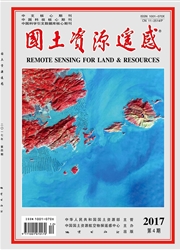

 中文摘要:
中文摘要:
为研究我国近10 a月平均NDVI空间分布特征,使用2005―2014年MOD/MYD13C2植被指数产品得到全国多年分月NDVI; 在考虑不同月份NDVI高、中、低值区面积变化的同时,结合DEM数据,分析植被覆盖随季节变化的规律和NDVI随坡向、海拔的变化规律。结果表明: NDVI低值段[-0.25,0.15)面积冬季高、夏季低,代表裸土、荒地和部分水体的特征; 中值段[0.15,0.55)面积呈“双峰双谷”分布,春、秋季高于冬、夏季,体现植被覆盖下混合地物的特征; 高值段[0.55,0.95]面积夏季高、冬季低,反映了植被覆盖随季节变化的规律。NDVI随坡向变化呈“双峰双谷”分布,东南、西北坡高于西南、东北坡。NDVI随海拔升高出现3个递减带(250~1 250 m,2 500~3 000 m和3 750~6 000 m)和2个递增带(1 250~2 500 m和3 000~3 750 m)。受我国气候及地理、地形等要素影响,NDVI的水平和垂直向空间分异显著。此规律可为陆面过程研究提供参考。
 英文摘要:
英文摘要:
In order to study the spatial distribution characteristics of monthly mean NDVI during the past ten years in China, the authors used MODIS MOD/MYD13C2 vegetation spectrum to synthesize monthly NDVI and, combined with China’s terrain data, discussed the changing regularity of NDVI with respect to aspect and elevation.The results show that the area ratio of low NDVI value segment [-0.25,0.15)is high in winter and low in summer, suggesting the characteristics of bare soil, deserted land and water.The median segment[0.15, 0.55] shows the "bimodal double-dip" character, and the area ratio is higher in spring and autumn than in winter and summer, implying features of vegetated mixture land cover.The area ratio of high value segment [0.55, 0.95] is high in summer and low in winter, indicating variation of vegetation cover with seasonal change.NDVI change with aspect shows the "bimodal double-dip" distribution, the NDVI values in southeast and northwest aspects are larger than those in southwest and northeast aspects.With increasing elevation , three NDVI decreasing zones are 250~1 250 m, 2 500~3 000m and 3 750~6 000 m, and two NDVI increasing zones are 1 250~2 500 m and 3 000~3 750 m, respectively.The horizontal and vertical distribution differentiations of NDVI are remarkable, which is attributed to the impact of climate and geographical terrain elements in China.Those regularities may be helpful to the research on land surface process.
 同期刊论文项目
同期刊论文项目
 同项目期刊论文
同项目期刊论文
 Estimation of monthly average sunshine duration over China based on cloud fraction from MODIS satell
Estimation of monthly average sunshine duration over China based on cloud fraction from MODIS satell Allometric Scaling and Resource Limitations Model of Tree Heights: Part 1. Model Optimization and Te
Allometric Scaling and Resource Limitations Model of Tree Heights: Part 1. Model Optimization and Te Mapping Annual Precipitation across Mainland China in the Period 2001–2010 from TRMM3B43 Product Usi
Mapping Annual Precipitation across Mainland China in the Period 2001–2010 from TRMM3B43 Product Usi Spatial Downscaling of Monthly TRMM Precipitation Based on EVI and Other Geospatial Variables Over t
Spatial Downscaling of Monthly TRMM Precipitation Based on EVI and Other Geospatial Variables Over t 期刊信息
期刊信息
